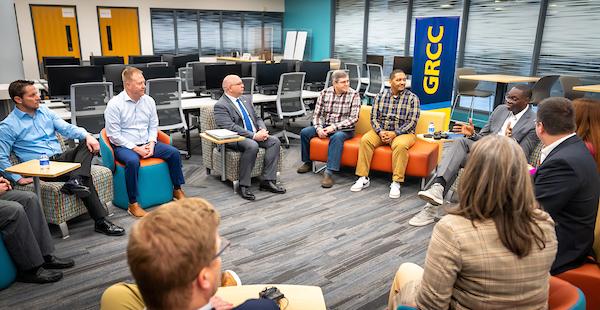Oct. 9, 2023 GRAND RAPIDS, Mich. – The total economic impact created by Grand Rapids Community College in 2020-21 was $1 billion, according to a new study commissioned by the college.
That includes an operations spending impact of $110.2 million, construction spending impact of $7.3 million, student spending impact of $31.9 million and alumni impact of $898.4 million.
“The Economic Value of the Grand Rapids Community College,” by Lightcast, broke down GRCC’s impact in Kent and Ottawa counties and the results were significant in both.
GRCC President Charles Lepper, nearing the end of one year on the job, was pleased to see the findings. He said the results demonstrate that GRCC is a strong investment for students, taxpayers and society.
“GRCC creates value from multiple perspectives,” he said. “We generate more in tax revenue than we receive which is significant. But beyond that, GRCC plays a key role in helping students increase their employability and achieve their individual potential. The college draws students to the region, generating new dollars and opportunities. And GRCC provides students with the education, training and skills they need to have fulfilling and prosperous careers.”
GRCC benefits regional businesses by increasing consumer spending in the region and supplying a steady flow of qualified, trained workers to the workforce, Lightcast said.
It also determined that the college enriches the lives of students by raising their lifetime earnings and helping them achieve their individual potential.
The college also benefits state and local taxpayers through increased tax receipts and a reduced demand for government-supported social services and benefits society as a whole in Michigan by creating a more prosperous economy and generating a variety of savings through the improved lifestyles of students.
Altogether, Lightcast found that the social benefits of GRCC equal a present value of $2.8 billion. These benefits include $1.9 billion in added student income, $760.8 million in added business income, $131.2 million in added income from college activities, as well as $58.5 million in social savings related to health, the justice system, and income assistance in Michigan.
“People in Michigan invested a present value total of $192.2 million in GRCC in fiscal year 2020-21,” Lepper noted. “That means for every dollar invested in GRCC, people in Michigan will receive a cumulative value of $14.80 in benefits.”
Lepper added that an interesting aspect of Lightcast’s findings was that society as a whole in Michigan benefits from the presence of GRCC in two major ways.
Primarily, he said, society benefits from an increased economic base in the state. This is attributed to the added income from students’ increased lifetime earnings (added student income) and increased business output (added business income), which raises economic prosperity in Michigan.
But benefits to society also consist of the savings generated by the improved lifestyles of GRCC students (education is statistically correlated with a variety of lifestyle changes that generate social savings). In 2020-21, GRCC served 19,836 credit and 11,394 non-credit students. Those students will receive a stream of higher future earnings that will continue to grow throughout their working lives.
For example, the average GRCC associate degree graduate from 2020-21 will see annual earnings that are $9,600 higher than a person with a high school diploma or equivalent. In addition, around 18% of credit students attending GRCC originated from outside the region in 2020-21 and some of those students stayed, adding new talent to the area.
In 2020-21, the college employed 1,338 full-time and part-time faculty and staff, all of whom lived in the GRCC Service Region. Total payroll at GRCC was $91.6 million, much of which was spent in the region for groceries, mortgage and rent payments, dining out and other household expenses. The college also spent $57.3 million on day-to-day expenses related to facilities, supplies, and professional services.
Grand Rapids Community College has been offering educational opportunities in West Michigan for more than 100 years. Established in 1914, the college offers degree courses, certification and training programs, and workshops and personal enrichment classes. Offerings are held on GRCC’s downtown Grand Rapids campus, and at several locations throughout Kent and Ottawa counties, as well as through distance learning.
